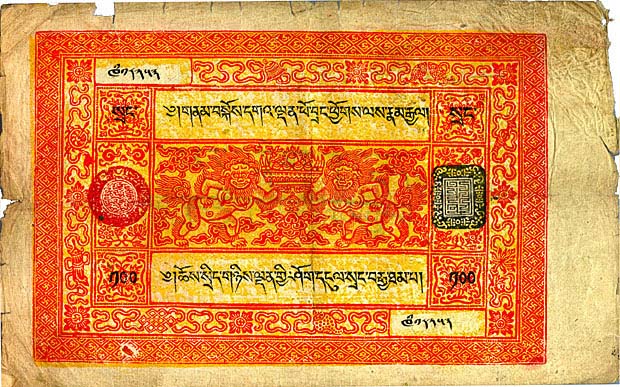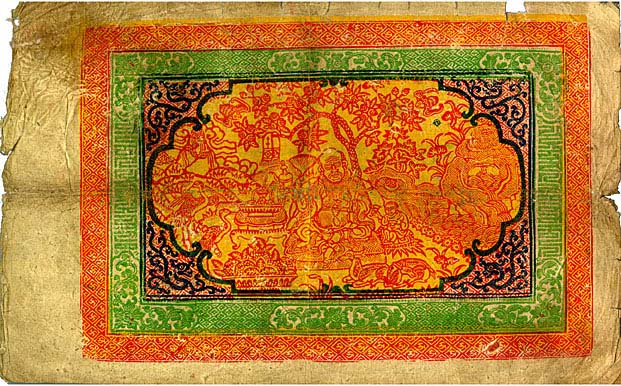The use of money in China could be traced back to at least four thousand years ago. China was also the first country to use paper money, or credit currency in the world. Ancient paper money can only be described in general terms for lack of material objects. About the Pai-Lu P'i-pi  (white deer-skin money) of Han Dynasty and the Fei-Chien (white deer-skin money) of Han Dynasty and the Fei-Chien  (flying money) of Tang Dynasty, I personally have never seen the actual objects. However, the official issuing of paper money in Sung Dynasty is famous in the field of numismatic. [Chiao-Tzu (flying money) of Tang Dynasty, I personally have never seen the actual objects. However, the official issuing of paper money in Sung Dynasty is famous in the field of numismatic. [Chiao-Tzu  (1008AD) and Chien-Yin (1008AD) and Chien-Yin  (1105AD) of Northern Sung and Hui-Tzu (1105AD) of Northern Sung and Hui-Tzu  (1160AD) and Kuan-Tzu (1160AD) and Kuan-Tzu  (1131AD) of Southern Sung]. The use of paper moneys went on through the Yuan and Ming as well as the end of the Qing Dynasty. In 1897, China's first bank, the Commercial Bank of China was established by Sheng Hsuen Huai (1131AD) of Southern Sung]. The use of paper moneys went on through the Yuan and Ming as well as the end of the Qing Dynasty. In 1897, China's first bank, the Commercial Bank of China was established by Sheng Hsuen Huai  with the approval of the emperor, and beginning of issuing modern banknotes in China. Paper notes played their important roles in different stages of the money history of China. with the approval of the emperor, and beginning of issuing modern banknotes in China. Paper notes played their important roles in different stages of the money history of China. |
Paper Money issued by
Tibetan Regional Government
with Secret Security Text
Marks of Rareness of the Collected Currencies
Extremely Rare A ~ Very Rare B ~ Rare C ~ Not So Many D ~ Common E
| Mint Evolution and Peculiarity No.: 044 Size: 117 x 182 mm Mint: Lhasa Rareness: E |
|
Note: According to the books of "The History of Tibetan Money" by Mr. Hsiao Huai Yuan and "Standard Catalog of World Paper Money" by Mr. Albert Pick , this Tibetan note is a common note. But, it is very strange that I collected this note about ten years ago, afterwards, I have never met that kinds of note again in Hong Kong. [Of course, except the counterfeit Tibetan notes, don't forget, no Tibetan notes have been issued for 37 years, so there should not be so many complete new Tibetan notes appeared. Be careful!!] During the recent years, by the help of the fellow collectors, I have collected several other Tibetan items which are really rarer than this 100 srang note. This has proved what I thought was wrong before, this 100 srang note is not a rare item. The more important, I have learnt more about the rarity of the collecting rules that one collector may have several specimens of an item which to another has remained unobtainable. I wish to post more Tibetan notes in the near future. |
Obverse |
 |
| Obverse
This note was first printed by Cha-Hsi Motor Plant  or Cha-Hsi Le-K'ung Mint [The Lhasa Mint of the Tibet Government] in 1937. or Cha-Hsi Le-K'ung Mint [The Lhasa Mint of the Tibet Government] in 1937.
It is printed in red and yellow from blocks bearing various patterns on paper. [100 Srang note needed to repeat printing for 13 times.] The red outer frame is ornated with the rhomboid patterns. The first inner frame is ornated with the common patterns, Symbol of eight good omens. The top left and bottom right corners of the inner frame are each ornated with the two black serial numbers filled in with a pen in Tibetan script for security. The top corners of the second inner frame of the note are ornated with the two Tibetan characters "Srang" means tael whereas the two bottom vertices bear the Tibetan Numbers "100". Nine Tibetan text  , meaning the "Tibetan government is all victorious anywhere", is printed horizontally across the top centre of the second inner frame in black. The row of Tibetan words , meaning the "Tibetan government is all victorious anywhere", is printed horizontally across the top centre of the second inner frame in black. The row of Tibetan words  , meaning the "Government and Religion in one and the paper money valued at 100 Srang" printed horizontally across the bottom centre of the second inner frame in black. Two lions are holding with a fruit bowl is printed at the centre of the note between two geometrical seals, Dalai Lama's red circular seal and Cha-Hsi Le-K'ung Mint black rectangular seal. , meaning the "Government and Religion in one and the paper money valued at 100 Srang" printed horizontally across the bottom centre of the second inner frame in black. Two lions are holding with a fruit bowl is printed at the centre of the note between two geometrical seals, Dalai Lama's red circular seal and Cha-Hsi Le-K'ung Mint black rectangular seal.
|
Reverse

Reverse The red outer frame is same as the obverse ornated with the rhomboid patterns. But the inner frame is printed with flower patterns in green. Two seated holy men under the linden (lime tree) are printed at the centre of the note with two cranes [means longevity] at left and two deers [means prosperity] lie on the ground in front of the lames. The old holy man is holding with a magic bottle. [means fertilizing the earth]. Two fling bats [means felicity; fortune] are printed at the top left and right. Background of the two holy men is designed with landscape of mountains and cloud. This 100 Srang note was made by pasting together 2 sheets of papers, the rear one having a 2-line security legend printed on it. When you hold up the note facing yourself to a light source, you can see the direct reading of the security text is printed at the center of the note between the two sheets of papers. |

More about Tibetan Paper Money
5 Srang Note
More about Tibetan Coinage
Szechuan Rupee : the Imitation of Indian Rupee
More about K'ang Ting Rupee
The Red Face Rupee
More about Tibetan Coinage
Tibetan Coinage I - The Nepalese and Tibetan Coinage in Qing Dynasty
More about Tibetan Coinage
Tibetan Coinage II - The Kong-par Tangka Coins
 , located at northern outskirts of Lhasa, and was established in 1932, as a part of the Cha-Hsi Mint. All the products of the Kam-Tung Paper Factory served the Cha-Hsi Mint only. The materials using to make paper containing with the root of a kind of poisonous weed
, located at northern outskirts of Lhasa, and was established in 1932, as a part of the Cha-Hsi Mint. All the products of the Kam-Tung Paper Factory served the Cha-Hsi Mint only. The materials using to make paper containing with the root of a kind of poisonous weed  in order to prevent the spoiling by the insects and the rats. The paper was soft and tough with plain surface. [counterfeit note existed with vertical texture on the surface] Each month, the factory produced 5000 boxes of paper only, and 500 to 1000 pieces per each box.
in order to prevent the spoiling by the insects and the rats. The paper was soft and tough with plain surface. [counterfeit note existed with vertical texture on the surface] Each month, the factory produced 5000 boxes of paper only, and 500 to 1000 pieces per each box.  :
:  1987 p.17, 51, 55, 60. (The History of Tibetan Money).
1987 p.17, 51, 55, 60. (The History of Tibetan Money).